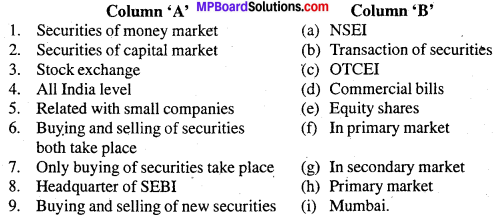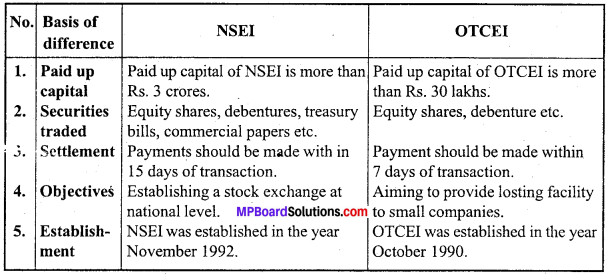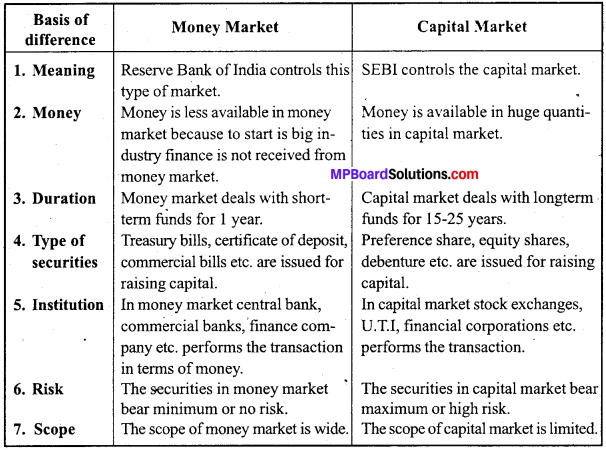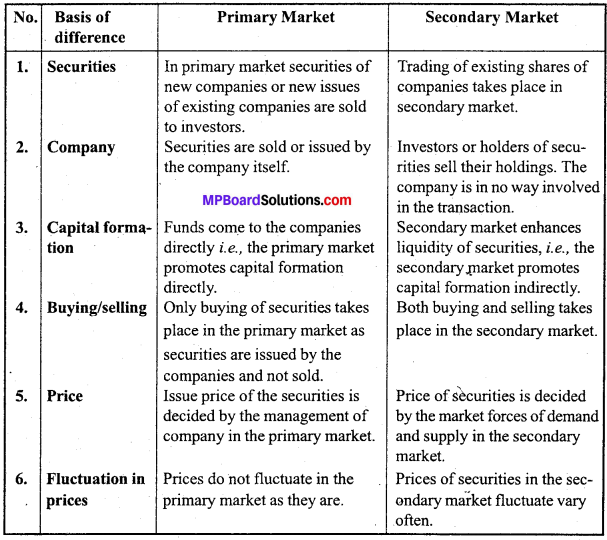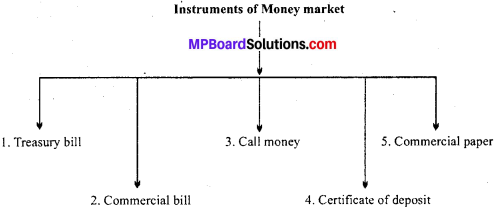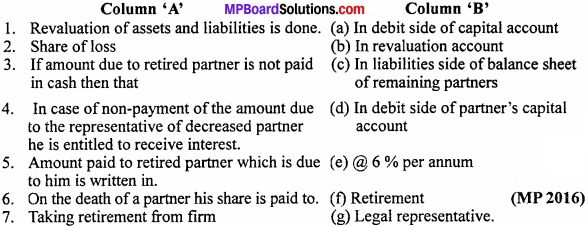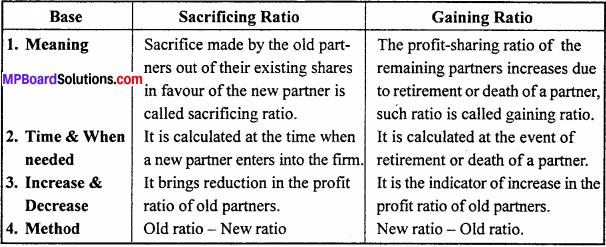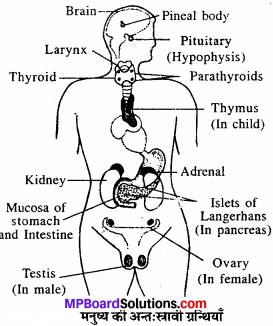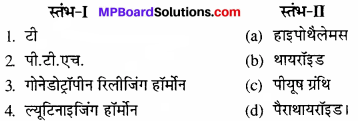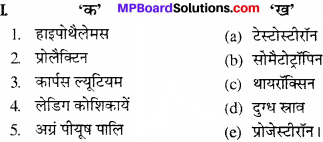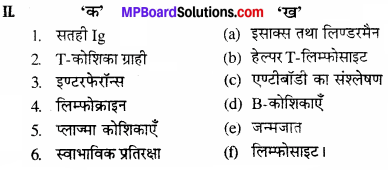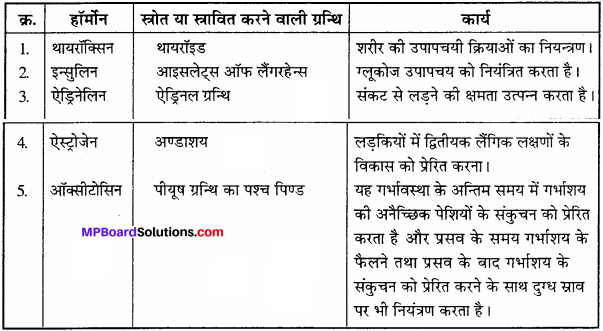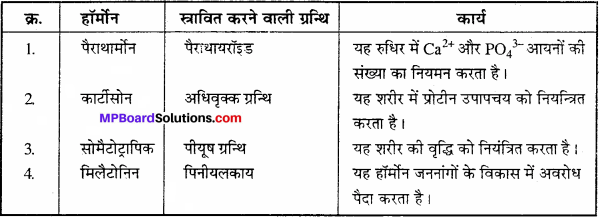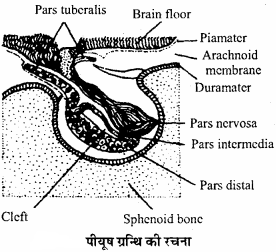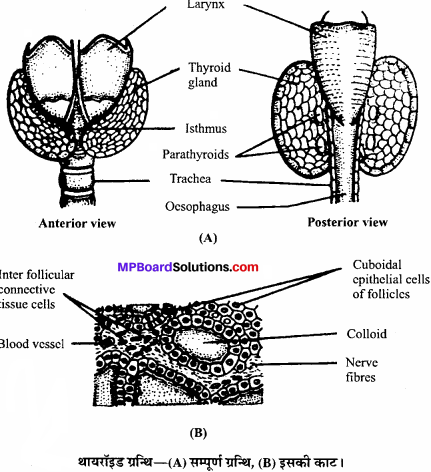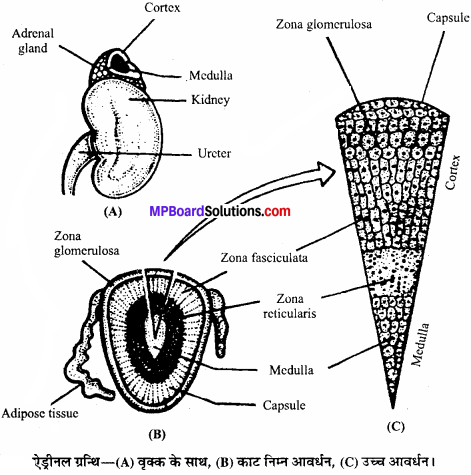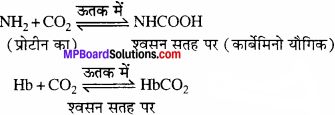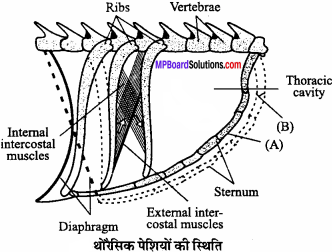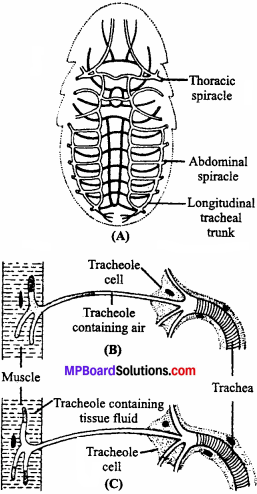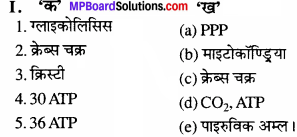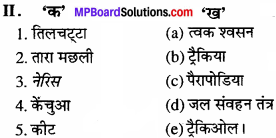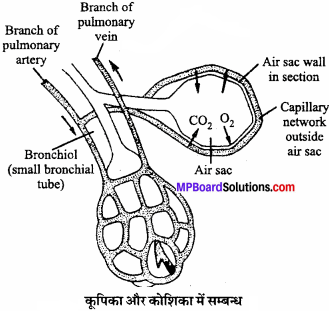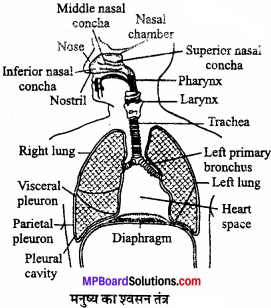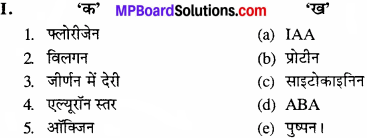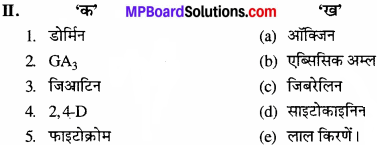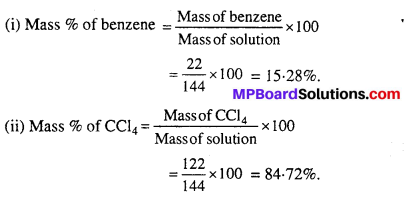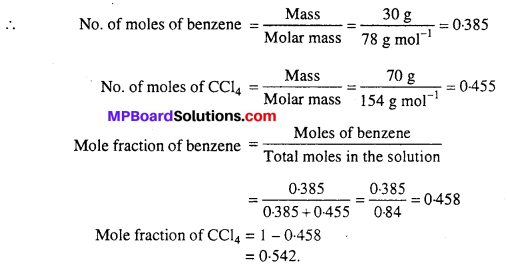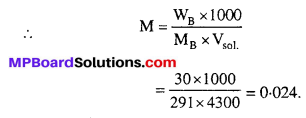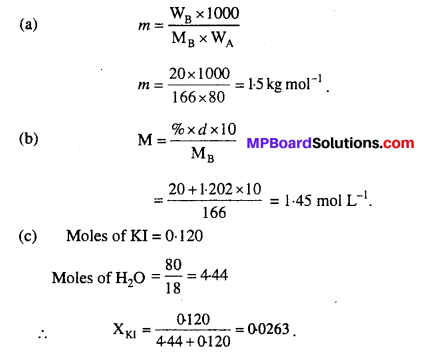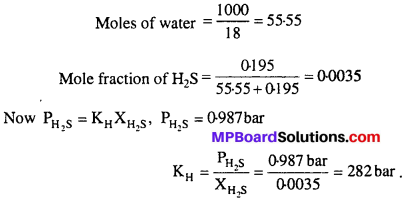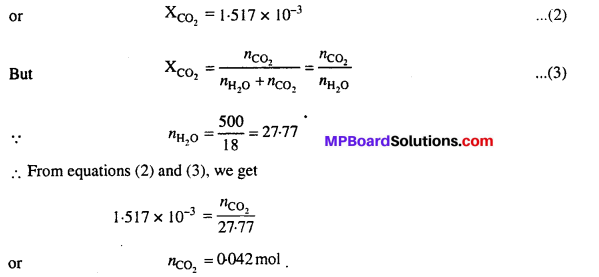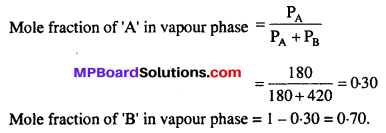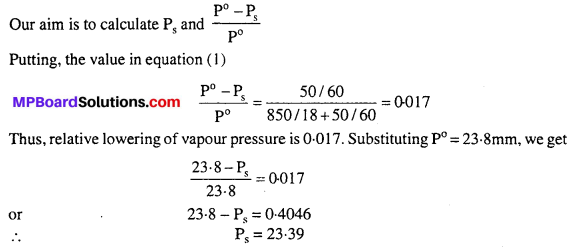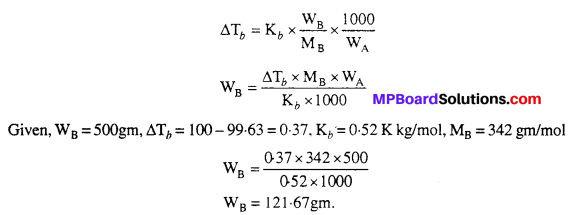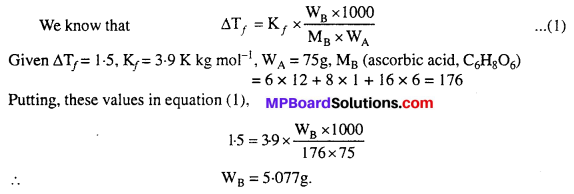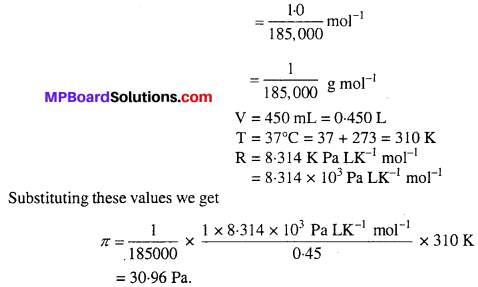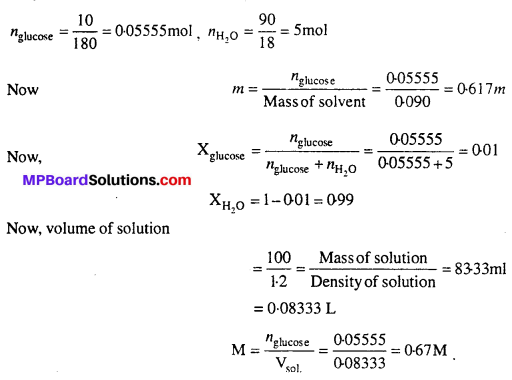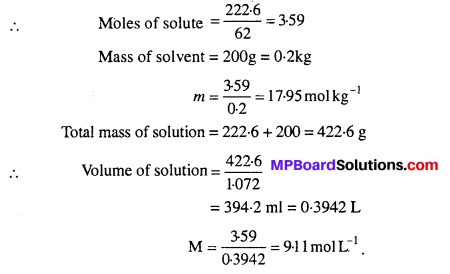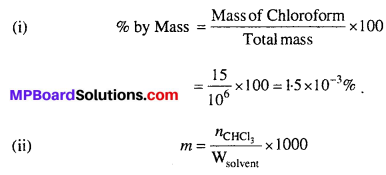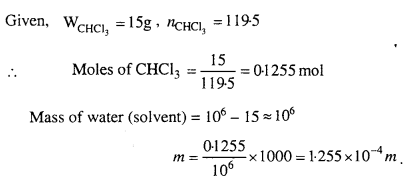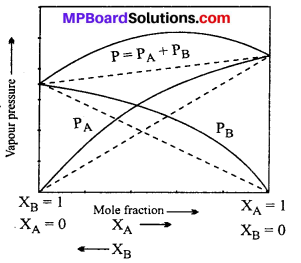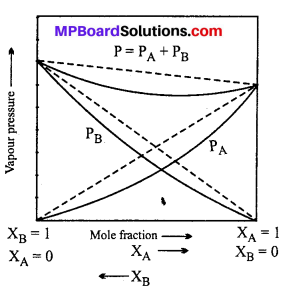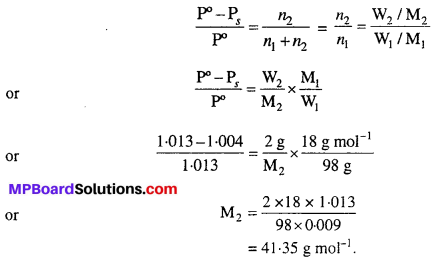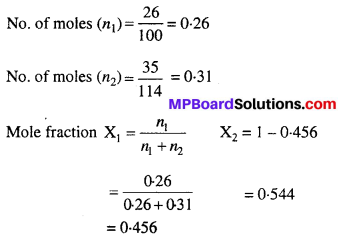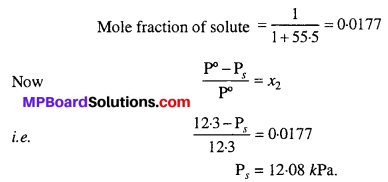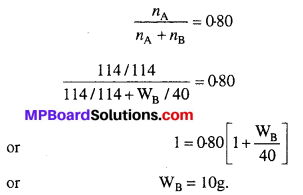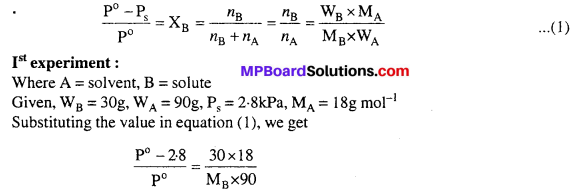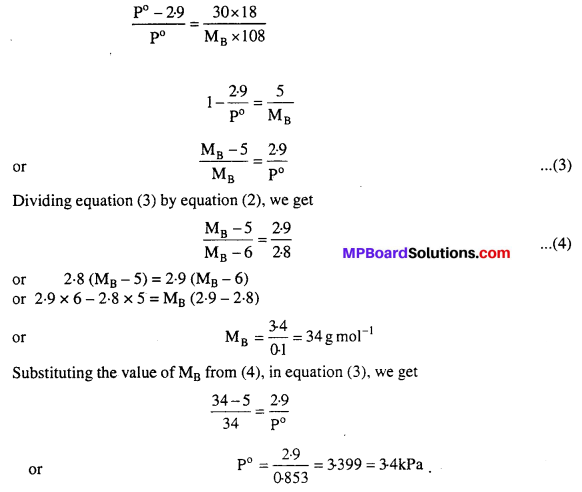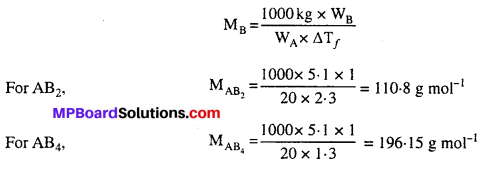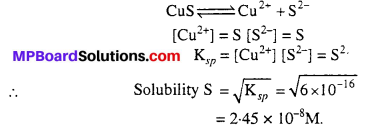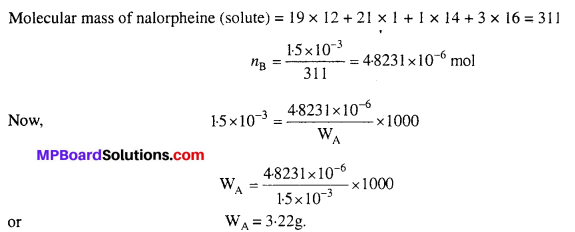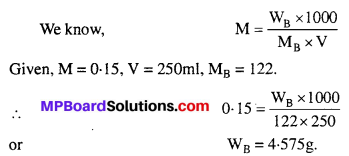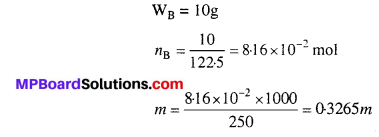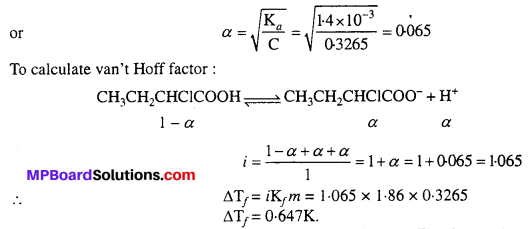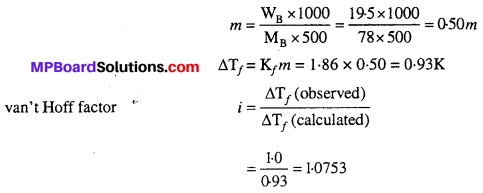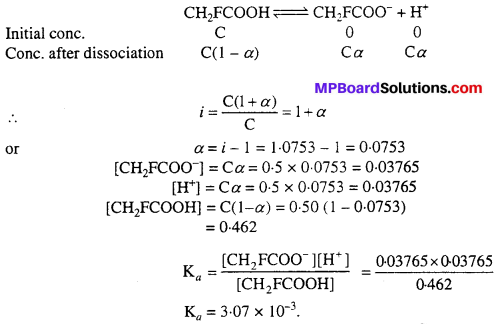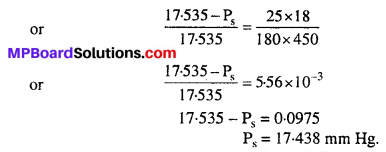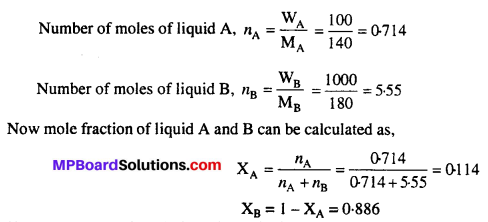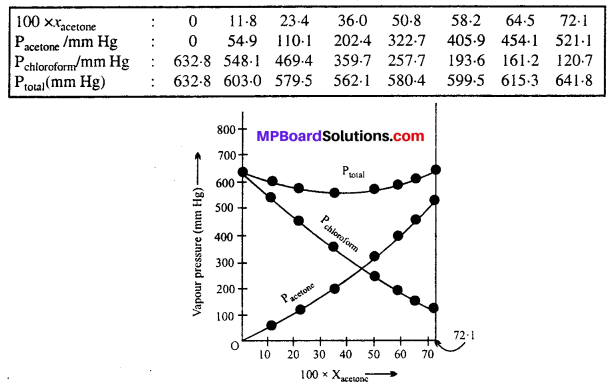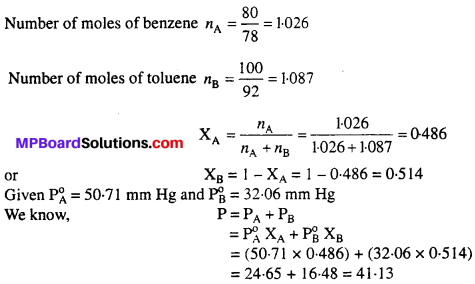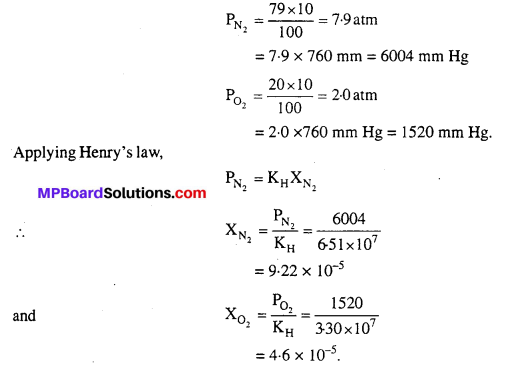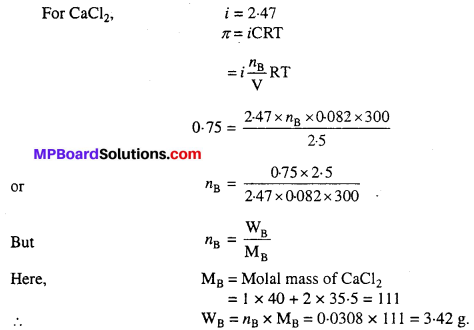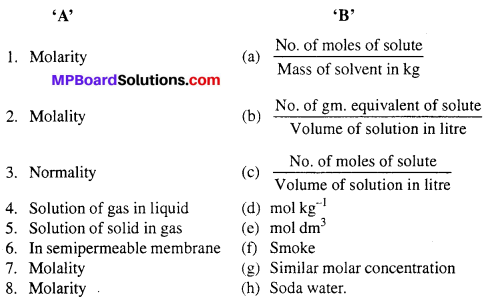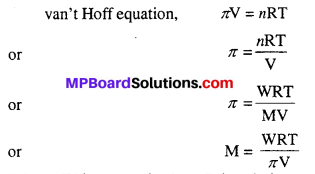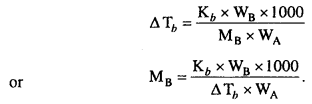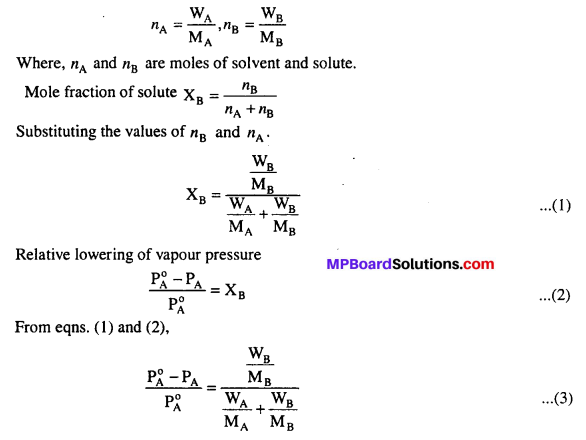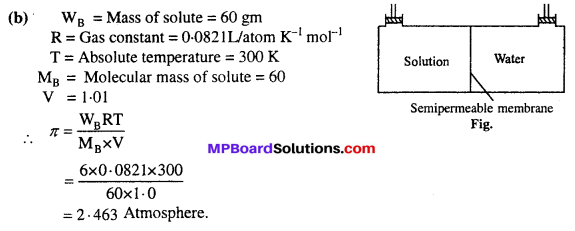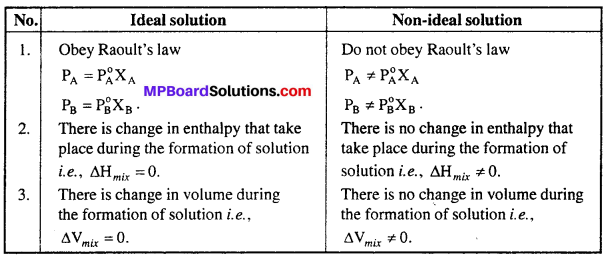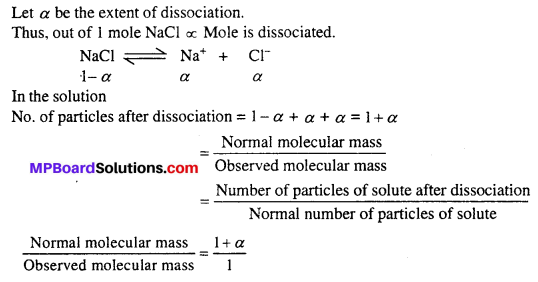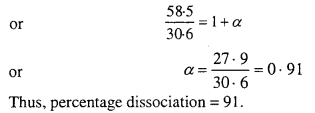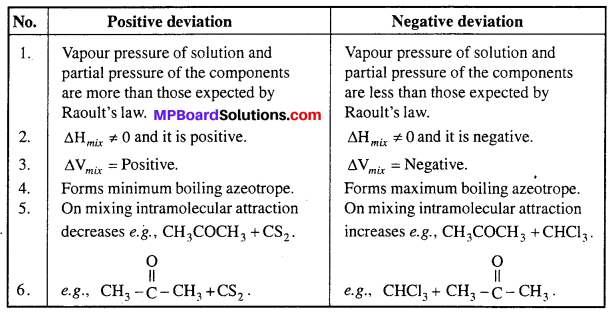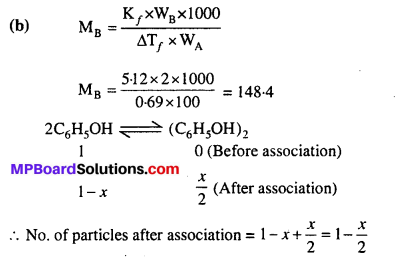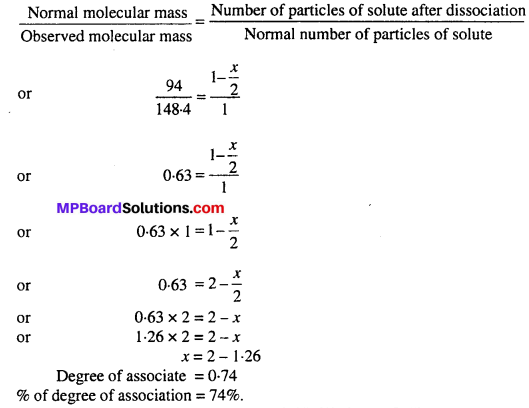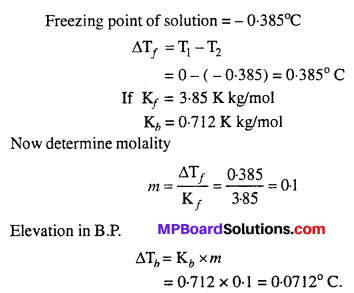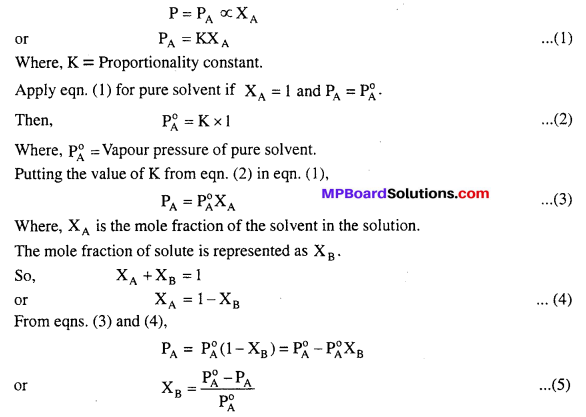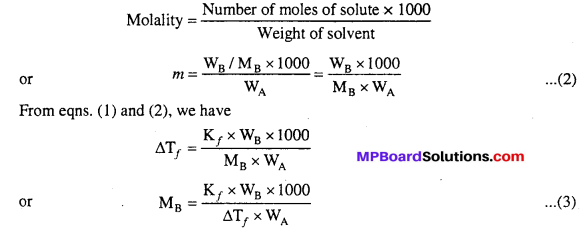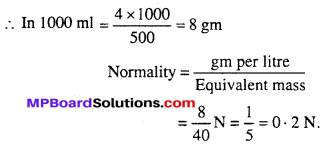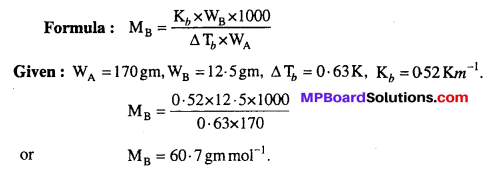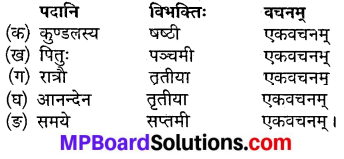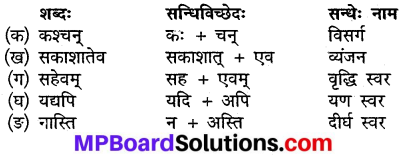MP Board Class 12th Economics Important Questions Unit 10 भुगतान संतुलन
भुगतान संतुलन Important Questions
भुगतान संतुलन वस्तुनिष्ठ प्रश्न
प्रश्न 1.
सही विकल्प चुनकर लिखिए –
प्रश्न (a)
भुगतान शेष की संरचना में निम्नलिखित में कौन – से खाते सम्मिलित होते हैं –
(a) चालू खाता
(b) पूँजी खाता
(c) और (b) दोनों
(d) इनमें से कोई नहीं।
उत्तर:
(c) और (b) दोनों
प्रश्न (b)
व्यापार सन्तुलन का अर्थ होता है –
(a) पूँजी के लेन – देन से
(b) वस्तुओं के आयात व निर्यात से
(c) कुल क्रेडिट तथा डेबिट से
(d) उपर्युक्त सभी।
उत्तर:
(b) वस्तुओं के आयात व निर्यात से
![]()
प्रश्न (c)
भुगतान शेष की संरचना में निम्नलिखित में कौन – से खाते सम्मिलित होते हैं –
(a) चालू खाता
(b) पूँजी खाता
(c) (a) और (b) दोनों
(d) इनमें से कोई नहीं।
उत्तर:
(c) (a) और (b) दोनों
प्रश्न (d)
प्रतिकूल भुगतान सन्तुलन में सुधार का उपाय है –
(a) मुद्रा अवमूल्यन
(b) आयात प्रतिस्थापन
(c) विनिमय नियंत्रण
(d) उपर्युक्त सभी।
उत्तर:
(d) उपर्युक्त सभी।
प्रश्न (e)
विदेशी विनिमय दर का निर्धारण होता है –
(a) विदेशी करेंसी की माँग द्वारा
(b) विदेशी करेंसी की पूर्ति द्वारा
(c) विदेशी विनिमय बाजार में माँग एवं पूर्ति द्वारा
(d) इनमें से कोई नहीं।
उत्तर:
(c) विदेशी विनिमय बाजार में माँग एवं पूर्ति द्वारा
![]()
प्रश्न (f)
विदेशी विनिमय बाजार के रूप हैं –
(a) हाजिर या चालू बाजार
(b) वायदा बाजार
(c) (a) और (b) दोनों
(d) इनमें से कोई नहीं।
उत्तर:
(c) (a) और (b) दोनों
प्रश्न 2.
रिक्त स्थानों की पूर्ति कीजिए –
- ब्रेटन वुड्स प्रणाली को ……………………….. सीमा प्रणाली भी कहा जाता है।
- विदेशी विनिमय दर एवं विदेशी विनिमय की पूर्ति में ………………………….. संबंध होता है।
- अवमूल्यन से देश की मुद्रा की विनिमय क्रयशक्ति ………………………….. हो जाती है।
- व्यापार संतुलन में केवल …………………………… मदों को शामिल किया जाता है।
- भुगतान – संतुलन सदैव ………………………….. में रहता है।
- एक देश की मुद्रा का दूसरे देश की मुद्रा में व्यक्ति मूल्य ………………………….. कहलाता है।
उत्तर:
- समंजनीय
- सीधा
- कम
- दृश्य
- संतुलन
- विनिमय दर।
![]()
प्रश्न 3.
सत्य /असत्य बताइये –
- व्यापार संतुलन में दृश्य मदों तथा अदृश्य मदों दोनों का समावेश किया जाता है।
- व्यापार संतुलन भुगतान संतुलन का एक अंग है।
- अवमूल्यन की घोषणा सरकार द्वारा की जाती है।
- भुगतान संतुलन सदैव सन्तुलित रहता है।
- निर्यात प्रोत्साहन हेतु अवमूल्यन का सहारा लिया जाता है।
- विकासशील देशों में तेजी से बढ़ती हुई जनसंख्या का आर्थिक विकास पर अनुकूल प्रभाव पड़ता है।
- भुगतान संतुलन करने का एक उपाय निर्यात प्रोत्साहन भी है।
उत्तर:
- असत्य
- सत्य
- सत्य
- सत्य
- सत्य
- असत्य
- असत्य।
प्रश्न 4.
सही जोड़ियाँ बनाइये –

उत्तर:
- (b)
- (c)
- (a)
- (e)
- (d).
![]()
प्रश्न 5.
एक शब्द/वाक्य में उत्तर दीजिये –
- नई व्यापार नीति की घोषणा किस सन में की गई?
- भारतीय रुपये के अवमूल्यन से भारतीयों के आयात कैसे हो जायेंगे?
- दीर्घकाल में आयात किसका भुगतान करते हैं?
- पूँजी खाते से किस बात का ज्ञान होता है?
- एक देश की मुद्रा का दूसरे देश की मुद्रा में व्यक्त मूल्य क्या कहलाता है?
उत्तर:
- 1991
- महँगे
- निर्यात का
- अंतर्राष्ट्रीय विनियोग व ऋणग्रस्तता का
- विनिमय दर।
भुगतान संतुलन लघु उत्तरीय प्रश्न
प्रश्न 1.
स्थिर विनिमय दर से आप क्या समझते हैं?
उत्तर:
स्थिर विनिमय दर से तात्पर्य उस दर से है जो अन्तर्राष्ट्रीय व्यापार में स्थिर बनी रहती है। सन् 1944 में अन्तर्राष्ट्रीय मुद्रा कोष की स्थापना के साथ एवं विश्वव्यापी मंदी एवं स्वर्णमान, के पतन के परिणामस्वरूप विनिमय दरों में स्थिरता की प्रवृत्ति बढ़ी। इस दर को अधिकीलित दर भी कहा जाता है। इसे निम्न चित्र से स्पष्ट किया जा सकता हैइस विनिमय दर व्यवस्था में दर का निर्धारण सरकार के द्वारा किया जाता है।
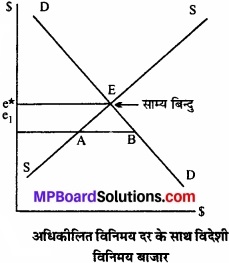
प्रश्न 2.
लोचपूर्ण विनिमय दर क्या है?
उत्तर:
लोचपूर्ण विनिमय दर वह दर है जो केन्द्रीय बैंक के हस्तक्षेप के बिना विदेशी विनिमय की माँग और पूर्ति में साम्य स्थापित करती है। जिस बिन्दु पर विदेशी विनिमय की माँग एवं पूर्ति की शक्तियों के द्वारा दर निर्धारित हो वह साम्य या लोचपूर्ण विनिमय दर कहलाती है।
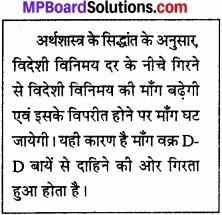
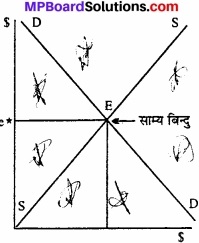
प्रश्न 3.
भुगतान संतुलन से क्या आशय है? भारत के भुगतान संतुलन की प्रतिकूलता के तीन कारण लिखिए?
अथवा
भुगतान शेष में असंतुलन का कारण लिखिए?
उत्तर:
भुगतान संतुलन का अर्थ:
भुगतान संतुलन से आशय, किसी देश – विशेष की वस्तुओं के आयातों एवं निर्यातों तथा उनके मूल्यों के संपूर्ण विवरण से होता है। सामान्यतः विभिन्न देशों के बीच विभिन्न वस्तुओं के आयात – निर्यात के अतिरिक्त अन्य प्रकार के भी लेन – देन होते हैं, जैसे – बीमा, जहाजी किराया, बैंकों का शुल्क, ब्याज, लाभ, पूँजी का स्थानांतरण सेवाओं का पुरस्कार इत्यादि। भारत में भुगतान संतुलन की प्रतिकूलता के कारण-भारत में भुगतान संतुलन के प्रतिकूल होने के तीन कारण निम्नलिखित हैं –
1. पेट्रोलियम पदार्थों के आयात में वृद्धि:
तेल उत्पादक देश अपने पेट्रोलियम पदार्थों के मल्य प्रतिवर्ष बढ़ाते रहते हैं। साथ – ही – साथ देश में पेट्रोलियम पदार्थों की खपत बढ़ी है जिससे भारी मात्रा में इनका आयात किया गया है।
2. आशा के अनुरूप निर्यातों में वृद्धि न होना:
भारत में भुगतान संतुलन के प्रतिकूल होने का एक कारण निर्यातों का आशानुरूप न बढ़ना है।
3. बढ़ती हुई जनसंख्या:
भारत की जनसंख्या वृद्धि के कारण आयातों में वृद्धि हुई है। तथा घरेलू उपभोग के बढ़ जाने के कारण निर्यातों में कमी आई है जिससे भारत की भुगतान संतुलन में प्रतिकूलता आई है।
![]()
प्रश्न 4.
भारत में भुगतान संतुलन को सुधारने हेतु चार उपाय बताइए?
उत्तर:
भारत में भुगतान संतुलन को सुधारने के उपाय इस प्रकार हैं –
1. निर्यात को प्रोत्साहन:
सरकार को निर्यात को प्रोत्साहित करना चाहिए, ताकि निर्यात बढ़ सके इसके लिए –
- निर्यात करों में कमी की जानी चाहिए
- देश में उद्योगों को आर्थिक सहायता दी जानी चाहिए
- विदेशों में वस्तुओं के लिए प्रचार व विज्ञापन किया जाना चाहिए।
2. आयात में कमी:
भारत को अपने आयात में कमी लानी चाहिए। इसके लिए आयात करों में वृद्धि की जानी चाहिए)जिससे आयातिक वस्तु महँगी हो जाए और माँग में कमी आए।
3. विदेशी ऋणों का प्रयोग:
भुगतान संतुलन की प्रतिकूलता को दूर करने के लिए विदेशी ऋणों का भी प्रयोग किया जा सकता है)। वास्तव में यह कुछ समय के लिए इस समस्या का समाधान तो कर देता है लेकिन बाद में भुगतानों को अदा करते समय कठिनाई होती है।
4. विनिमय नियंत्रण:
भुगतान संतुलन को ठीक करने के लिए विनिमय नियंत्रण भी एक अच्छा मार्ग है। इससे आयात घटते हैं एवं निर्यात बढ़ते हैं।
प्रश्न 5.
स्थिर विनिमय – दर के पक्ष – विपक्ष में दो – दो तर्क दीजिए?
उत्तर:
स्थिर विनिमय दर से आशय:
जब विनिमय – दर का निर्धारण सरकार के द्वारा किया जाता है तो उसे स्थिर विनिमय दर कहते हैं।
स्थिर विनिमय – दर के पक्ष में तर्क:
स्थिर विनिमय – दर के पक्ष में निम्नांकित तर्क दिये जा सकते हैं –
1. अंतर्राष्ट्रीय व्यापार को प्रोत्साहन:
स्थिर विनिमयदर के अंतर्गत आयातकर्ता एवं निर्यातकर्ता को इस बात की जानकारी रहती है कि कितना भुगतान करना है तथा कितना भुगतान प्राप्त होगा।
2. विनिमय व्यवस्था:
यदि देश में विनिमय – दर स्थिर है तो सट्टेबाजी जैसी प्रवृत्तियों को प्रोत्साहन नहीं मिलता है तथा सरकार विनिमय नियंत्रण तथा प्रबंध व्यवस्थाओं से मुक्त हो जाती है।
3. निर्यातक देशों के लिए आवश्यक जिन देशों को राष्ट्रीय आय का अधिकांश भाग निर्यातों से ही प्राप्त होता है उनके लिये विनिमय दर में स्थायित्व अत्यधिक आवश्यक है।
4. पूँजी निर्माण:
विदेशी विनिमय दर में स्थिरता के फलस्वरूप देश में आंतरिक कीमत स्तर पर भी अनुकूल प्रभाव पड़ता है। पूँजी निर्माण की दर बढ़ती है तथा देश का आर्थिक विकास होता है।
स्थिर विनिमय – दर के विपक्ष में तर्क:
स्थिर विनिमय – दर के विपक्ष में निम्नांकित तर्क दिए जाते हैं –
1. आर्थिक विकास पर प्रतिकूल प्रभाव:
स्थिर विनिमय – दर का प्राथमिक उद्देश्य इसमें स्थिरता को बनाये रखना होता है और राष्ट्रीय आय, रोजगार नीति, मूल्य – स्तर जैसे राष्ट्रीय उद्देश्यों को गौण मान लिया जाता है।
2. भ्रष्टाचार:
स्थिर विनिमय – दर को बनाये रखने के लिए देश में अनेक नियंत्रण लगाये जाते हैं। नियंत्रण अधिक होने पर भ्रष्टाचार फैलने के अवसर बढ़ जाते हैं।
![]()
प्रश्न 6.
व्यापार संतुलन एवं भुगतान संतुलन में अन्तर स्पष्ट कीजिए?
उत्तर:
व्यापार संतुलन एवं भुगतान संतुलन में अन्तर –
व्यापार संतुलन
- व्यापार संतुलन में आयात – निर्यात की जाने वाली दृश्य मदों को ही शामिल किया जाता है।
- व्यापार संतुलन, भुगतान संतुलन का एक भाग है।
- किसी देश का व्यापार संतुलन पक्ष में न होना कोई अधिक चिन्ता का विषय नहीं है।
- व्यापार संतुलन अनुकूल या प्रतिकूल हो सकता है।
- व्यापार की दृष्टि से व्यापार संतुलन का महत्व कम होता है।
भुगतान संतुलन:
- भुगतान संतुलन में दृश्य मदों के साथ – साथ अदृश्य मदों को ही शामिल किया जाता है।
- भुगतान संतुलन की धारणा अधिक व्यापक होती है।
- यदि भुगतान संतुलन पक्ष में नहीं है तो यह चिन्ता का विषय है।
- भुगतान संतुलन सदा ही संतुलित रहता है।
- भुगतान संतुलन का महत्व अधिक होता है।
प्रश्न 7.
अवमूल्यन और मूल्यह्रास में अंतर स्पष्ट कीजिए?
उत्तर:
अधिकीलित विनिमय प्रणाली में जब सरकार के द्वारा विनिमय दर में वृद्धि की जाती है तो इसे मुद्रा का अवमूल्यन कहा जाता है। अवमूल्यन तब होता है जब देश स्थिर विनिमय दर प्रणाली को ग्रहण करता है। दूसरी ओर, बाजार माँग एवं पूर्ति शक्तियों के प्रभाव से बिना किसी सरकारी हस्तक्षेप के देश की मुद्रा का मूल्य कम हो जाता है तो इसे मूल्यह्रास कहते हैं, मूल्यह्रास तब होता है जब देश नम्य विनिमय दर प्रणाली अथवा तिरती विनियम दर प्रणाली को ग्रहण करता है।
![]()
प्रश्न 8.
जब M = 60 + 0.06 Y हो, तो आयात की सीमांत प्रवृत्ति क्या होगी? आयात की सीमांत प्रवृत्ति और समस्त माँग फलन में क्या संबंध है?
उत्तर:
दिया है,
M = 60 + 0. 60 Y
∵ M = \(\bar { M } \) + mY
∴ m = 0.06
\(\bar { M } \) > 0 स्वायत्त घटक है। 0 < m < 1
यहाँ m आयात की सीमांत प्रवृत्ति है। सीमांत प्रवृत्ति का मान 1 से कम तथा शून्य से अधिक होता है। आय का एक अतिरिक्त रुपया आयात खर्च करने से प्राप्त अनुपात है। यह सीमांत प्रवृत्ति के सादृश्य होता है। आयात की सीमांत प्रवृत्ति और समस्त माँग में धनात्मक संबंध पाया जाता है।
प्रश्न 9.
व्याख्या कीजिए कि – G – T = (Sg – I) – (X – M)?
उत्तर:
G – T = (Sg – I) – (X – M)
यहाँ, G = सरकारी व्यय, T = कर, G – T = निवल सरकारी व्यय, Sg = सरकार की बचत, I = निवेश, Sg – I = निवल बचतें, x = निर्यात, M= आयात, X – M = व्यापार संतुलन। यह दिया गया समीकरण सही है, चूँकि यह स्पष्ट करता है कि निवल सरकारी व्यय, निवल सरकारी बचतों और व्यापार संतुलन के समान है।
प्रश्न 10.
क्या चालू पूँजीगत घाटा खतरे का संकेत होगा? व्याख्या कीजिए?
उत्तर:
चालू पूँजीगत घाटा खतरे का संकेत होगा या नहीं। इस संदर्भ में तर्क दिया जाता है कि जब किसी देश में चालू पूँजीगत घाटा होता है तो बचत कम हो रही होती है, निवेश बढ़ोत्तरी हो रही होती है अथवा बजट घाटे में वृद्धि हो रही होती है। देश के दीर्घकालीन परिप्रेक्ष्य के बारे में चिन्ता का कारण तब होता है जब चालू पूँजीगत घाटे से बचत कम होती है और बजटीय घाटा अधिक होता है। घाटे से उच्च निजी उपभोग अथवा सरकारी उपभोग प्रतिबिंबित होता है।
इन स्थितियों में देश के पूँजी स्टॉक में तेजी से वृद्धि नहीं होगी जिससे पर्याप्त संवृद्धि हो सके और ऋण अदायगी की जा सके। परंतु यदि चालू पूँजीगत घाटे से निवेश में वृद्धि प्रतिबिंबित हो तो चिन्ता का कोई कारण नहीं होता है क्योंकि इससे पूँजी स्टॉक का अधिक तीव्रता से निर्माण होगा और भविष्य में निर्गत में वृद्धि होगी। अतः संक्षेप में हम यह कह सकते हैं कि यदि किसी देश में ऋण की नई निधि से ब्याज दर की अपेक्षा विकास दर अधिक होती है तो चालू पूँजीगत घाटे से किसी प्रकार के खतरे का संकेत नहीं होता।
प्रश्न 11.
संतुलित व्यापार शेष और चालू खाता संतुलन में अंतर स्पष्ट कीजिए?
उत्तर:
संतुलित व्यापार शेष:
- आयात एवं निर्यात के संतुलन को संतुलित व्यापार व्यापार शेष कहा जाता है।
- यह एक संकुचित धारणा है।
- इमसें केवल भौतिक वस्तुओं के आयात निर्यात को ही शामिल किया जाता है।
चालू खाता संतुलन:
- व्यापार शेष, सेवाओं के आयात व निर्यात शेष तथा हस्तांतरण भुगतान शेष के योग को चालू खाता संतुलन कहते हैं।
- यह एक संकुचित धारणा है।
- भौतिक वस्तुओं के निर्यात – आयात के साथ – साथ सेवाओं व हस्तांतरण भुगतान के लेन – देन को भी इसमें शामिल किया जाता है।
![]()
प्रश्न 12.
यदि देश B से देश A में मुदा स्फीति ऊँची हो और दोनों देशों में विनिमय दर स्थिर हो, तो दोनों देशों के व्यापार शेष का क्या होगा?
उत्तर:
यदि देश ‘B’ से देश ‘A’ में मुद्रा स्फीति की दर ऊँची हो और दोनों देशों में विनिमय दर स्थिर हो, तो देश ‘A’ में व्यापार शेष घाटा होगा और देश B में व्यापार शेष आधिक्य होगा। ऐसी स्थिति में देश B से देश A को वस्तुओं का आयात करना लाभप्रद होगा। परिणामस्वरूप देश A अधिक वस्तुओं का अधिक मात्रा में आयात करेगा और देश B को कम मात्रा में वस्तुओं का निर्यात करेगा।अत: देश A के सामने व्यापार शेष घाटे की समस्या उत्पन्न होगी। दूसरी ओर देश B देश A से कम मात्रा में वस्तुओं का आयात करेगा। अतः देश B का व्यापार शेष धनात्मक होगा।
भुगतान संतुलन दीर्घ उत्तरीय प्रश्न
प्रश्न 1.
भुगतान संतुलन की मदों का उल्लेख कीजिए?
उत्तर:
किसी देश का भुगतान संतुलन उसके समस्त विदेशी लेन – देन तथा लेनदारियों – देनदारियों का विवरण होता है। इसके बाँयी ओर सभी लेनदारियाँ तथा दाँयी ओर देनदारियाँ प्रदर्शित की जाती हैं बाँयी ओर की मदों एवं दाँयी ओर के मदों के अंदर के स्वरूप से भुगतान संतुलन का स्वरूप स्पष्ट हो जाता है। भुगतान संतुलन के विवरण में सम्मिलित विभिन्न मदों का वर्गीकरण लीग ऑफ नेशन्स ने दो मुख्य शीर्षकों के अंतर्गत किया था और अधिकांश देश इसी आधार पर भुगतान संतुलन का विवरण तैयार करते हैं। भुगतान संतुलन का प्रथम शीर्षक चालू खाता होता है और दूसरा शीर्षक पूँजी खाता होता है।
- चालू खाता: चालू खाते में दृश्य और अदृश्य मदें सम्मिलित होती हैं।
- पूँजी खाता: इसमें विदेशी पूँजी के विनियोग तथा ऋण की राशियों को दिखाया जाता है।
प्रश्न 2.
पूँजी खाते में शामिल मदों को बताइए?
उत्तर:
पूँजी खाते में शामिल प्रमुख मदें निम्नलिखित हैं –
- बैंकिंग पूँजी का प्रवाह: बैंकिंग पूँजी का अंतरप्रवाह देश के लिए प्राप्ति पक्ष तथा बाह्य प्रवाह भुगतान पक्ष में गिना जाता है, लेकिन बैंकिंग पूँजी में केन्द्रीय बैंक को शामिल नहीं किया जाता हैं।
- निजी ऋण: देश के निजी क्षेत्र द्वारा विदेशों से प्राप्त ऋण, भुगतान संतुलन खाते के लेनदारी पक्ष तथा उनके ऋण भुगतानों को लेनदारी पक्ष में गिना जाता है।
- विदेशी निवेश: विदेशी निवेश में दो प्रकार के निवेश आते हैं –
- प्रत्यक्ष विदेशी निवेश:
- प्रत्यक्ष विदेशी निवेश से तात्पर्य विदेशों में परिसम्पत्तियाँ खरीदना है तथा उन पर नियंत्रण रखना है।
- पोर्टफोलियो निवेश:
- इस निवेश में विदेशों में परिसम्पत्तियाँ खरीदी जाती हैं परन्तु उस पर नियंत्रण नहीं होता है।
- सरकारी पूँजी का लेन – देन:
इसमें निम्नलिखित मदें शामिल हैं –
- ऋण
- ऋणों का भुगतान
- मिश्रित
- कोष एवं मौद्रिक सोना।
![]()
प्रश्न 3.
विदेशी विनिमय – दर को प्रभावित करने वाले तत्वों को लिखिए?(कोई चार)
अथवा
विदेशी विनिमय – दर के उतार – चढ़ाव के पाँच कारण समझाइए?
उत्तर:
विदेशी विनिमय – दर को प्रभावित करने वाले प्रमुख तत्व निम्न हैं –
1. आयात एवं निर्यात में परिवर्तन:
यदि देश के निर्यात, आयात से अधिक हैं तो देश की मुद्रा की माँग बढ़ेगी और विदेशी विनिमय:
दर देश के पक्ष में होगा इसके विपरीत देश में आयात, निर्यात की तुलना में अधिक है तो विदेशी मुद्रा की माँग बढ़ेगी और विदेशी विनिमय दर देश के विपक्ष में होगा या प्रतिकूल होगा।
2. बैंकिंग संबंधी प्रभाव:
यदि व्यापारिक बैंक विदेशी बैंक पर बड़ी मात्रा में बैंकर्स ड्रॉफ्ट तथा अन्य प्रकार के साख-पत्र जारी करता है, तो इससे विदेशी विनिमय की मांग बढ़ जायेगी इसके विपरीत अगर विदेशी बैंक देश के बैंकों पर साख – पत्र जारी करती है तो देशी मुद्रा की मांग बढ़ेगी और विनिमय-दर देश के पक्ष में हो जाती है।
3. कीमतों में परिवर्तन:
दो देशों में किसी एक देश में सापेक्षिक दृष्टि से कीमत के परिवर्तन के परिणामस्वरूप विनिमय-दर परिवर्तित हो जाती है। जैसे – भारत में कीमत बढ़ जाती है, जबकि जर्मनी में कीमत में परिवर्तन नहीं होता है। अतः जर्मनी को भारत की वस्तुएँ महँगी पड़ने लगेंगी और वे यहाँ से कम वस्तुएँ मँगायेंगे। इसके विपरीत भारत को जर्मनी की वस्तुएँ सस्ती पड़ेंगी और वहाँ से आयात करने लगेंगी।
4. पूँजी का आगमन:
जिस देश में विदेशी पूँजी आती है उस देश की मुद्रा की मांग बढ़ जाती है। परिणामस्वरूप विदेशी विनिमय दर उस देश के पक्ष में हो जाती है। इसके विपरीत पूँजी देश से विदेश में जाती है तो विदेशी मुद्रा की माँग बढ़ जाती है। जिससे विनिमय दर देश के विपक्ष में हो जाती है।
प्रश्न 4
दृश्य आयात – निर्यात तथा अदृश्य आयात – निर्यात को समझाइये?
उत्तर:
दृश्य आयात – निर्यात:
दृश्य आयात – निर्यात के अंतर्गत उन वस्तुओं के आयात – निर्यात को शामिल किया जाता है जिनका बंदरगाह में रखे गये रजिस्टर में लेखा – जोखा रखा जाता है। इसे देखकर वर्षभर में किए गए आयातों एवं निर्यातों के मूल्य प्राप्त किये जा सकते हैं। इसलिए इसे दृश्य मदें कहा जाता है। इसमें केवल वस्तुओं के आयात – निर्यात को ही शामिल किया जाता है।
अदृश्य आयात – निर्यात:
अदृश्य आयात – निर्यात के अंतर्गत सेवाओं के आदान – प्रदान को शामिल किया जाता है। ये सेवाएँ हैं – बैंकिंग, बीमा, शिपिंग आदि जिनका बंदरगाहों पर लेखा – जोखा नहीं रखा जाता है। इस प्रकार अदृश्य मदों में सेवाओं एवं पूँजी के आयात – निर्यात को शामिल किया जाता है।
![]()
प्रश्न 5.
लोचपूर्ण विनिमय – दर किसे कहते हैं? इसके पक्ष – विपक्ष में दो – दो तर्क दीजिए?
उत्तर:
लोचपूर्ण विनिमय – दर का अर्थ:
जब विनिमय दर का निर्धारण विदेशी मुद्रा बाजार में करेंसियों की माँग एवं पूर्ति के द्वारा निर्धारित किया जाता है तो उसे लोचपूर्ण विनिमय – दर कहते हैं।
लोचपूर्ण विनिमय – दर के पक्ष में तर्क:
लोचपूर्ण विनिमय दर के पक्ष में निम्नलिखित तर्क दिये जाते हैं –
1. भुगतान संतुलन में साम्य:
लोचपूर्ण विनिमय दर की दशा में अन्य राष्ट्रीय हितों, जैसे-राष्ट्रीय आय, मूल्य स्तर आदि की उपेक्षा किये बिना भुगतान-संतुलन में साम्य स्थापित करना संभव होता है।
2. अधिमूल्यन एवं अवमूल्यन:
लोचपूर्ण विनिमय दर होने पर अपने देश की मुद्रा को विदेशी मुद्रा की तुलना में आसानी से बढ़ाया या घटाया जा सकता है। इससे अर्थव्यवस्था में साम्य बनाये रखना संभव होता है।
![]()
प्रश्न 6.
मान लीजिए C = 100 + 0.75 YD, I = 500, G = 750, कर आय का 20 प्रतिशत है, x = 150, M = 100 + 0.2Y तो संतुलन आय, बजट घाटा अथवा आधिक्य और व्यापार घाटा अथवा आधिक्य की गणना कीजिए?
उत्तर:
C = 100 + 0.75 YD जहाँ C = 100, C = 0.75, I = 500, G = 750, X = 150, M = 100 + 0.2Y
कर आय (t) = 20%
आय
(Y) = C + C (1 – 1) Y + l + G + (X – M)
Y = 100 + 0.75 (1 – 0.2) Y + 500 +750 + (150 – 100 – 0 – 2Y)
Y = 100 + 0.75(0.8) Y+ 500 + 750 + 150 – 100 – 0 – 2Y
Y = 100 + 0.6 Y + 1300 – 0.2 Y = 1400 + 0.4 Y
Y – 0.4 Y = 1400
0.6 Y = 1400
Y = \(\frac{1400}{0.6}\)
= 2333
बजट घाटा = सरकारी व्यय कर (G) – कर
= 750 – 2333 का 20% = 750 – 467 = 283
M = 100 + 0.2 Y = 100 + 0.2(2333)
= 100 + 467 = 567
व्यापार घाटा = M – X = 567 – 150 = 417.

